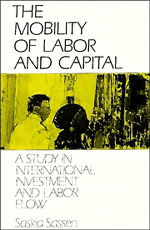Book contents
- Frontmatter
- Contents
- List of tables
- Acknowledgements
- Introduction
- 1 Foreign investment: a neglected variable
- 2 The use of foreign workers
- 3 The new immigration
- 4 The globalization of production: implications for labor migration
- 5 The rise of global cities and the new labor demand
- 6 The reconcentration of capital in the United States: a new investment zone?
- Conclusion
- Notes
- References
- Index
- Frontmatter
- Contents
- List of tables
- Acknowledgements
- Introduction
- 1 Foreign investment: a neglected variable
- 2 The use of foreign workers
- 3 The new immigration
- 4 The globalization of production: implications for labor migration
- 5 The rise of global cities and the new labor demand
- 6 The reconcentration of capital in the United States: a new investment zone?
- Conclusion
- Notes
- References
- Index
Summary
Immigration to the United States has changed from a preponderance of high-wage countries of origin in the 1950s to one of low-wage countries of origin in the 1970s. This recomposition cannot be taken for granted, especially since the family reunion emphasis of the 1965 Immigration Act was expected to bring in the relatives of those already here, i.e., mostly Europeans. Secondly, the data show that there has been a massive increase in annual entries, even excluding undocumented immigrants. From 265,000 in 1960, annual entries reached 570,000 in 1985 and about 1 million if we include all entries, a level approximating the peak period at the turn of the century. Thirdly, the data show a tendency toward concentration in a limited number of large metropolitan areas: New York City is the major recipient of immigrants from the Caribbean Basin, including several South American countries, while Los Angeles, San Francisco and, again, New York City are the major recipients of Asians.
Thus the new Caribbean Basin and Asian immigration can be seen as (a) backing up two low-wage immigrations that began earlier – Mexicans to Los Angeles and other West Coast cities and Puerto Ricans to New York City; and (b) geographically complementing the large and continuing flow of Mexicans into the Sunbelt.
- Type
- Chapter
- Information
- The Mobility of Labor and CapitalA Study in International Investment and Labor Flow, pp. 55 - 93Publisher: Cambridge University PressPrint publication year: 1988



